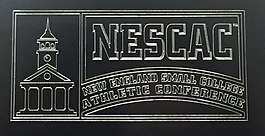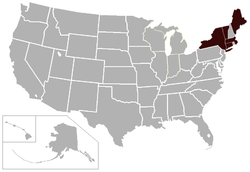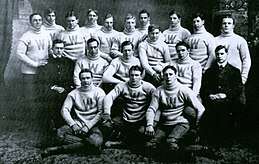New England Small College Athletic Conference
The New England Small College Athletic Conference (NESCAC) is an American collegiate athletic conference comprising sports teams from eleven highly selective liberal arts institutions of higher education in the Northeastern United States. The eleven institutions are Amherst College, Bates College, Bowdoin College, Colby College, Connecticut College, Hamilton College, Middlebury College, Tufts University, Trinity College, Wesleyan University, and Williams College.
| New England Small College Athletic Conference | |
|---|---|
| NESCAC | |
 | |
| Established | 1971 |
| Association | NCAA |
| Division | Division III |
| Members | 11 |
| Sports fielded |
|
| Region | New England (except New Hampshire and Rhode Island) and New York |
| Headquarters | Hadley, Massachusetts |
| Commissioner | Andrea Savage (since 1999) |
| Website | nescac.com |
| Locations | |
 | |
The conference originated with an agreement among Amherst, Bowdoin, Wesleyan and Williams in 1955. In 1971, Bates, Colby, Hamilton, Middlebury, Trinity, Tufts, and Union College joined on and the NESCAC was officially formed. Union withdrew in 1977 and was replaced by Connecticut College in 1982. The members are grouped within the NCAA Division III athletic conference. Members of the conference have some of the largest financial endowments of any liberal arts colleges in the world, with Williams College's $2.6 billion being the largest. Undergraduate enrollment at the schools ranges from about 1,792 (Bates) to 5,500 (Tufts).
Members
Member colleges of the athletic conference possesses some of the largest financial endowments in the world. As of the 2016-2017 academic year, Williams College in Williamstown, Massachusetts, has the largest endowment of any college in the conference.[1][2]
| College | Location | Athletic nickname | Enrollment | 2017 endowment | Colors | Founded |
|---|---|---|---|---|---|---|
| Amherst College | Amherst, Massachusetts | Mammoths[note 1] | 1,839 | $2.25 billion[3] | 1821 | |
| Bates College | Lewiston, Maine | Bobcats | 1,832 | $345 million[4] | 1855 | |
| Bowdoin College | Brunswick, Maine | Polar Bears | 1,828 | $1.46 billion[5] | 1794 | |
| Colby College | Waterville, Maine | Mules | 1,838 | $775 million[6] | 1813 | |
| Connecticut College | New London, Connecticut | Camels | 1,844 | $290 million[7] | 1911 | |
| Hamilton College | Clinton, New York | Continentals | 1,905 | $905 million[8] | 1812 | |
| Middlebury College | Middlebury, Vermont | Panthers | 2,549 | $1.07 billion[9] | 1800 | |
| Trinity College | Hartford, Connecticut | Bantams | 2,172 | $614.8 million[10] | 1823 | |
| Tufts University | Medford, Massachusetts | Jumbos | 5,643 | $1.77 billion[11] | 1852 | |
| Wesleyan University | Middletown, Connecticut | Cardinals | 3,009 | $1 billion[12] | 1831 | |
| Williams College | Williamstown, Massachusetts | Ephs | 2,078 | $2.44 billion[13] | 1793 |
- Amherst's original, unofficial nickname for its teams, the Lord Jeffs, was retired in 2016 due to controversy over the propriety of honoring Lord Jeffrey Amherst.
History

Williams began its inaugural football season in 1881 and its rivalry with Amherst College is one of the longest at any level of college football.[14] Bates and Bowdoin have competed against each other athletically since the 1870s and subsequently share one of the ten oldest NCAA Division III football rivalries, in the United States, there is a long history of athletic competition between the two colleges and Colby.[15][16] Colby began its now most notable hockey rivalry, with Bowdoin in 1922.[17]
In 1899, Amherst, Wesleyan and Williams schools first began to compete together as the "Triangular League". Since then they have continued to play each other in most sports on a regular basis.[18][19][20][21] The conference originated with an agreement among Amherst, Bowdoin, Wesleyan and Williams in 1955.[22] Later, Bates, Colby, Connecticut College, Hamilton, Middlebury, Trinity, Tufts joined and the NESCAC was officially formed. The Conference was created out of a concern for the direction of intercollegiate athletic programs and remains committed to keeping a proper perspective on the role of sport in higher education.[22]
Member institutions believe athletic teams should be representative of school's entire student bodies and hew to NCAA Division III admissions and financial policies prohibiting athletic scholarships while awarding financial aid solely on the basis of need. Due to the prestigious reputations of its member schools, the NESCAC is able to attract many of the most athletically and intellectually gifted student-athletes in the country. Members stress that intercollegiate athletic programs should operate in harmony with the educational mission of each institution. Schools are committed to maintaining common boundaries to keep athletics strong yet in proportion to their overall academic mission. Presidents of each NESCAC institution control intercollegiate athletic policy. Conference tenets are usually more restrictive than those of the NCAA Division III regarding season length, number of contests and post-season competition.[22]
Membership timeline

Academics
| School | Grade deflation score | Source |
|---|---|---|
| Amherst | 84.5/100 | [23] |
| Bates | 85.5/100 | [23] |
| Bowdoin | 83.5/100 | [23] |
| Colby | 81.5/100 | [23] |
| Connecticut | N/A | [23] |
| Hamilton | 83.0/100 | [23] |
| Middlebury | 86.0/100 | [23] |
| Trinity | 77.5/100 | [23] |
| Tufts | N/A | [23] |
| Wesleyan | 87.0/100 | [23] |
| Williams | 89.0/100 | [23] |
Many schools in the New England Small College Athletic Conference are known for low grade inflation, grade deflation, and rigorous academic standards.[24][23] Some members have received limited media coverage over perceived grade inflation and deflation.[25][26][23]
The colleges are also known for a range of high and relatively low tuition rates and comprehensive fees. Some of the colleges have been named the most expensive in the United States.[27]
Geographic distribution
Most applicants to schools in the NESCAC come from the Northeast, largely from the New York City, Boston, and Philadelphia areas. As all NESCAC schools are located on the East Coast, and all but one are in New England, most graduates end up working and residing in the Northeast after graduation.[28]
Greek life
Many colleges banned fraternities and sororities on the grounds of unwarranted exclusivity, and provided on-campus social houses for all students to engage with. Williams College displaced their fraternity system in the 1960s due to high levels of racial and religious discrimination. Williams College President Chandler stated, "there remained the system of blackballing and secret agreements between some fraternities and their national bodies to exclude blacks and Jews... it was essentially a caste system based on socioeconomic status as perceived by students."[29]
Bates rejected the fraternity system in 1855, when it was founded. Colby disbanded its fraternities and sororities in 1984.[30] At Bowdoin, fraternities were phased out in 2000.[31] Despite the lack of Greek life, NESCAC schools are widely known for a prominent drinking culture.[32][33][34][35]
Schools within the NESCAC conference have made institutional efforts to diversify student body, and attract and wide range of students to their institutions. Many schools in the NESCAC provide significant financial aid to help increase the enrollment of lower income and middle class students.[36][37]
Notable alumni
Schools in the New England Small College Athletic Conference have graduated three U.S. presidents. The first president to graduate from the athletic conference was Franklin Pierce, the 14th President of the United States, a Bowdoin graduate of 1856.[38] The 20th president, James A. Garfield, graduated from Williams College in 1888.[39] The third U.S. president to graduate from a NESCAC institution was Calvin Coolidge, who graduated from Amherst College in 1895.[40] President Chester Arthur was an 1848 graduate of Union College,[41] a former NESCAC member, and President Woodrow Wilson was a professor at Wesleyan from 1888 to 1890.[42]
Competition and athletics
Four NESCAC institutions are among the 39 that founded the NCAA in 1905: Amherst, Tufts, Wesleyan, and Williams.[43] Prior to 1993 NESCAC generally did not allow member schools to send teams to NCAA championships. Since then all sports except football have had this freedom, many excelling in the NCAA Division III championships. The NACDA Directors' Cup, awarded since 1996 to the college or university in each NCAA Division that wins the most college championships, has been claimed at the Division III level by a NESCAC institution every year except 1998. In the 2012–13 season, four of the top ten NACDA Director's Cup institutions were from NESCAC: Williams (1), Middlebury (3), Amherst (6), and Tufts (8).[44]
Football scheduling
Until the 2017 season, the 10 football-playing NESCAC schools only played 8 regular season games. On April 27, 2017, the NESCAC announced that it would adopt a full 9-game round robin schedule.[45]
In addition to the ban on postseason play, the NESCAC football league is notable for member teams playing conference games only. While some Division II and Division III teams play only conference schedules, NESCAC is unique in all of its members playing only within conference games.[46]
Athletic spending
The U.S. Department of Education publishes statistics on athletic spending by colleges. In 2013–14, athletic spending by NESCAC schools was as follows:[47]
| School | Athletic spending | Amount per (unduplicated) athlete | Division III rank | Amount per student |
|---|---|---|---|---|
| Amherst | $5,822,492 | $10,324 | 41 | $3,262 |
| Bates | $5,181,170 | $7,631 | 15 | $3,293 |
| Bowdoin | $5,905,648 | $9,072 | 18 | $3,303 |
| Colby | $5,149,582 | $8,110 | 19 | $2,829 |
| Connecticut | $3,756,307 | $7,322 | 66 | $2,006 |
| Hamilton | $4,869,188 | $8,618 | 38 | $2,557 |
| Middlebury | $5,235,614 | $7,588 | 13 | $2,132 |
| Trinity | $5,885,489 | $8,945 | 16 | $2,752 |
| Tufts | $4,342,883 | $5,752 | 4 | $849 |
| Wesleyan | $5,379,896 | $9,134 | 24 | $1,863 |
| Williams | $7,276,419 | $9,780 | 5 | $3,548 |
Note: Nine (out of the eleven) NESCAC schools rank in the top 25 Division III for total athletic spending. With the exception of Connecticut College, all NESCAC schools rank in the top 10% of Division III for # of varsity athletes. Connecticut College athletic spending and # of varsity athletes are lowest because it does not have a football team. Tufts per-student athletic spending is low because it has nearly double the undergraduate population (5,100) of its nearest NESCAC rival (Wesleyan, with 2,800), and it has not emphasized athletic spending.
Conference venues
| School | Football | Basketball | Soccer | |||
|---|---|---|---|---|---|---|
| Stadium | Capacity | Arena | Capacity | Stadium | Capacity | |
| Amherst | Pratt Field | 8,000 | LeFrak Gymnasium | 2,450 | Hitchcock Field | 6,000 |
| Bates | Garcelon Field | 3,000 | Alumni Gymnasium | 750 | Russel Street Field | 4,000 |
| Bowdoin | Whittier Field | 9,000 | Morrell Gymnasium | 2,000 | Pickard Field | 4,500 |
| Colby | Harold Alfond Stadium | 5,000 | Wadsworth Gymnasium | 2,500 | Colby Soccer Field | 3,700 |
| Connecticut | Non-football school | N/A | Luce Fieldhouse | 800 | Freeman Field | 1,000 |
| Hamilton | Steuben Field | 2,500 | Margaret Bundy Scott Field House | 2,500 | Love Field | 2,500 |
| Middlebury | Youngman Field at Alumni Stadium | 3,500 | Pepin Gymnasium | 1,200 | Middlebury Soccer Field | 1,200 |
| Trinity | Jessee/Miller Field | 6,500 | Oosting Gym | 2,000 | Jessee/Miller Field | 6,500 |
| Tufts | Ellis Oval | 6,000 | Cousens Gym | 1,000 | Ellis Oval | 6,000 |
| Wesleyan | Andrus Field | 5,000 | Silloway Gymnasium | 1,200 | Jackson Field | 1,200 |
| Williams | Weston Field | 10,000 | Chandler Gymnasium | 2,900 | Weston Field | 10,000 |
See also
- The Little Ivies: a grouping of small liberal arts colleges, also in the Northeastern United States, comparable to Ivy League universities
- The Colby-Bates-Bowdoin Consortium: three small liberal arts colleges known as the "Maine Big Three"
- The Little Three: three small liberal arts colleges in Massachusetts and Connecticut comparable to the "Big Three"
References
- Convey, Eric (November 10, 2015). "Williams College's financial muscle grows with impressive endowment return". Boston Business Journal. Retrieved December 26, 2018.
- "Williams College Endowment Fund". endowments.com. Retrieved February 28, 2016.
- https://www.amherst.edu/system/files/media/2017%2520Audited%2520Financial%2520Statements.pdf
- http://www.bates.edu/accounting/files/2011/06/Financial-Statements-Bates-College-FY17.pdf
- https://www.bowdoin.edu/treasurer/pdf/2016-2017-audited-financial-statements.pdf
- http://www.colby.edu/vpadmin/wp-content/uploads/sites/157/2017/10/2016-17-Colby-Audited-Financial-Statement.pdf
- https://www.conncoll.edu/media/website-media/controller/FY17-Connecticut-College-audited-financial-statements.pdf
- https://www.hamilton.edu/documents/HamiltonCollegeFS2017.pdf
- http://www.middlebury.edu/system/files/media/Middlebury%20College%20FY17.pdf
- http://www.nacubo.org/-/media/Nacubo/Documents/research/2018-Endowment-Market-Values--Final.pdf
- http://finance.tufts.edu/budgetacc/files/2017_AnnualFinancialReport.pdf
- http://www.wesleyan.edu/giving/endowment.html
- https://controller.williams.edu/files/williams_financial_statement_2017-1.pdf
- "Williams". ephsports.williams.edu. Retrieved March 11, 2016.
- Nevin, David (1970). Muskie of Maine. Ladd Library, Bates College: Random House, New York. p. 99.
- Woz, Markus (2002). Traditionally Unconventional. Ladd Library, Bates College, Lewiston, Maine: Bates College. p. 6.
- Klein, Jeff Z. "Want a Real Rivalry? Try Bowdoin-Colby". Slap Shot. Retrieved March 11, 2016.
- One version of the facts: my life in ... - Henry Edmison Duckworth - Google Books. Books.google.com. Retrieved December 19, 2011.
- "The Global Language Monitor » Blog Archive » 2011 Top 300 Colleges and Universities Ranked by Internet 'Brand Equity'". Languagemonitor.com. Archived from the original on November 24, 2011. Retrieved December 19, 2011.
- "Around the Courts: College Squash Weekend Highlights (1/30/2011)". College Squash Association. Retrieved December 19, 2011.
- "M. Squash | Big tuneups versus 'Little Three'". The Daily Pennsylvanian. January 16, 2009. Archived from the original on July 8, 2011. Retrieved December 19, 2011.
- "NESCAC". nescac.com.
- Schimler, Stuart (2005). Reaching the Ivory Tower: College Admissions and Beyond. Empire Publishing, Inc. ISBN 9780976624608.
- "Amherst Mag - When It Comes to Grade Inflation, Think "When in Rome..."". Retrieved November 10, 2018.
- "The Amherst Student Opinion Grade Inflation Devalues Education". amherststudent-archive.amherst.edu. Archived from the original on April 8, 2016. Retrieved November 10, 2018.
- "Grade Inflation : EphBlog". ephblog.com. Retrieved November 10, 2018.
- Staley, Oliver. "Bates Charging $51,300 Leads Expensive U.S. Colleges List". Bloomberg.com. Retrieved May 16, 2016.
- Clark, Charles E. (2005). Bates Through the Years: an Illustrated History. Edmund Muskie Archives: Bates College, Lewiston, Maine. p. 37.
- Schonfeld, Zach. "Inside the Colleges that killed Frats for Good".
- digitalcommons.colby.edu/cgi/viewcontent.cgi?article=... Retrieved 2016-04-15
- Retrieved 2016-04-15
- "BSG discusses NESCAC alcohol survey, printing plan — The Bowdoin Orient". The Bowdoin Orient. Archived from the original on March 4, 2016. Retrieved February 28, 2016.
- "NESCAC Schools Survey Alcohol Use". The Middlebury Campus. Retrieved February 28, 2016.
- Zach. "NESCAC NEWS: Over 50 Colby Students Facing Alcohol Charges". Wesleying. Retrieved February 28, 2016.
- "Let's Talk About Booze Part 3". Archived from the original on March 11, 2016. Retrieved March 11, 2016.
- "Student Financial Services, Bates College". www.bates.edu. Retrieved March 11, 2016.
- "Financial Aid". finaid.williams.edu. Retrieved March 11, 2016.
- "Franklin Pierce: Life Before the Presidency—Miller Center". March 10, 2016. Archived from the original on March 10, 2016. Retrieved June 5, 2016.CS1 maint: unfit url (link)
- "James A. Garfield - U.S. Presidents - HISTORY.com". HISTORY.com. Retrieved June 5, 2016.
- "Calvin Coolidge: Life Before the Presidency—Miller Center". January 24, 2016. Archived from the original on January 24, 2016. Retrieved June 5, 2016.CS1 maint: unfit url (link)
- "FORMER U.S. PRESIDENT CHESTER ARTHUR, CLASS OF 1848, HONORED ON BIRTHDAY," https://muse.union.edu/newsarchives/2009/10/05/former-us-president-chester-arthur-class-of-1848-honored-on-birthday/
- David B. Potts, Wesleyan University, 1831–1910: Collegiate Enterprise in New ... (1999)
- NCAA News Archive - Founding members hold true to NCAA educational mission
- http://grfx.cstv.com/photos/schools/nacda/sports/directorscup/auto_pdf/2012-13/misc_non_event/june6DIIIupdated.pdf
- "NESCAC Football Moves to Full Round-Robin Schedule". www.nescac.com. Retrieved May 2, 2017.
- "NESCAC". nescac.com.
- "Equity in Athletics Data Analysis Cutting Tool Website". ed.gov.
